Related Research Articles

The Quran, also romanized Qur'an or Koran, is the central religious text of Islam, believed by Muslims to be a revelation from God. It is organized in 114 chapters which consist of individual verses. Besides its religious significance, it is widely regarded as the finest work in Arabic literature, and has significantly influenced the Arabic language.
Hafiz, literally meaning "protector", depending on the context, is a term used by Muslims for someone who has completely memorized the Quran. Hafiza is the female equivalent.
The mysterious letters are combinations of between one and five Arabic letters that appear at the beginning of 29 out of the 114 chapters (surahs) of the Quran just after the Bismillāh Islamic phrase. The letters are also known as fawātiḥ (فَوَاتِح) or "openers" as they form the opening verse of their respective surahs.
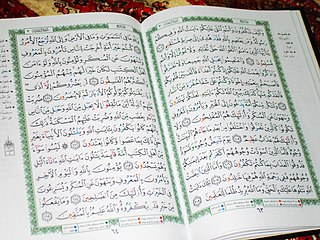
Mushaf is an Arabic word for a codex or collection of sheets, but also refers to a written copy of the Quran. The chapters of the Quran, which Muslims believe was revealed during a 23-year period in Muhammad's lifetime, were written on various pieces of paper during Muhammad's era. Two decades later, these papers were assembled into one volume under the third caliph, Uthman ibn Affan, and this collection has formed the basis of all written copies of the Quran to the present day.

In the context of the recitation of the Quran, tajwīd is a set of rules for the correct pronunciation of the letters with all their qualities and applying the various traditional methods of recitation (Qira'at). In Arabic, the term tajwīd is derived from the verb جود, meaning enhancement or to make something excellent. Technically, it means giving every letter its right in reciting the Qur'an.
The history of the Quran, the holy book of Islam, is the timeline and origin of the written compilations or manuscripts of the Quran, based on historical findings. It spans several centuries, and forms an important major part of the early history of Islam.
In Islam, Qirāʼah are different linguistic, lexical, phonetic, morphological and syntactical forms permitted with reciting the holy book of Islam, the Quran. Differences between Qiraʼat are slight and include varying rules regarding the prolongation, intonation, and pronunciation of words, but also differences in stops, vowels, consonants, and less frequently entire words. Qiraʼat also refers to the branch of Islamic studies that deals with these modes of recitation.

Rasm is an Arabic writing script often used in the early centuries of Classical Arabic literature. Essentially it is the same as today's Arabic script except for the big difference that the Arabic diacritics are omitted. These diacritics include i'jam, consonant pointing, and tashkil, supplementary diacritics. The latter include the ḥarakāt (حَرَكَات) short vowel marks—singular: ḥarakah (حَرَكَة). As an example, in rasm, the five distinct letters ـبـ ـتـ ـثـ ـنـ ـيـ are indistinguishable because all the dots are omitted. Rasm is also known as Arabic skeleton script.
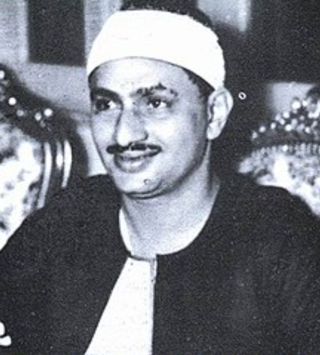
Muhammad Siddiq Al-Minshawi, known simply as Al-Minshawi, was an Egyptian Quranic reciter and Hafiz. Al-Minshawi was born into a Muslim Egyptian famous family. His grandfather, father, and brother were also famous Qurra. Nicknamed Al-Saut Al-Baki, he is part of a quadrumvirate, along with Abdul Basit, Mustafa Ismail, and Al-Hussary, which are considered to be the most important and famous Qurra of modern times to have an outsized impact on the Islamic World.

Uthman ibn Abduh ibn Husayn ibn Taha al-Halyabi is a Qazaq descent calligrapher of the Quran in the Arabic language renowned for hand-writing Mushaf al-Madinah issued by the King Fahd Complex for the Printing of the Holy Qur'an.

Sheikh Mahmoud Khalil al-Hussary also known as Al-Hussary, was an Egyptian qāriʾ widely acclaimed for his accurate recitation of the Qur'an. Al-Hussary committed the entire Qur'an to memory by age 8 and started reciting at public gatherings by age 12. In 1944, Al-Hussary won Egypt Radio's Qu'ran Recitation competition which had around 200 participants, including veterans like Muhammad Rifat. The quadrumvirate of El Minshawy, Abdul Basit, Mustafa Ismail, and Al-Hussary are generally considered the most important and famous qurrāʾ of modern times to have had an outsized impact on the Islamic world.
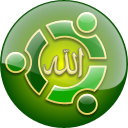
Sabily (Arabic: سبيلي, IPA:[sæˈbiːliː], My Way) is a discontinued Linux distribution based on Ubuntu, designed by and with the intent to be used by followers of Islam. Originally named Ubuntu Muslim Edition (presented as UbuntuME), development for Sabily was active from 2007 to 2011.

The Birmingham Quran manuscript is a single sheet of parchment on which two leaves of an early Quranic manuscript or muṣḥaf have been written. In 2015, the manuscript, which is held by the University of Birmingham, was radiocarbon dated to between 568 and 645 CE. It is part of the Mingana Collection of Middle Eastern manuscripts, held by the university's Cadbury Research Library.
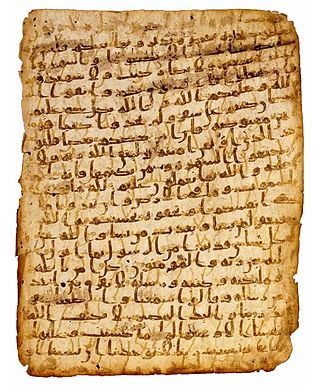
In Muslim tradition the Quran is the final revelation from God, Islam's divine text, delivered to the Islamic prophet Muhammad through the angel Jibril (Gabriel). Muhammad's revelations were said to have been recorded orally and in writing, through Muhammad and his followers up until his death in 632 CE. These revelations were then compiled by first caliph Abu Bakr and codified during the reign of the third caliph Uthman so that the standard codex edition of the Quran or Muṣḥaf was completed around 650 CE, according to Muslim scholars. This has been critiqued by some western scholarship, suggesting the Quran was canonized at a later date, based on the dating of classical Islamic narratives, i.e. hadiths, which were written 150–200 years after the death of Muhammad, and partly because of the textual variations present in the Sana'a manuscript. With the discovery of earlier manuscripts which conform to the Uthmanic standard however, the vast majority of Western revisionist theories regarding the historical origins of the Quran have fallen out of favor and been described as "untenable".
Abu Sa'id Uthman Ibn Sa‘id al-Qutbi, better known as Warsh (110-197AH), was a significant figure in the history of Quranic recitation (qira'at), the canonical methods of reciting the Qur'an. Alongside Qalun, he was one of the two primary transmitters of the canonical reading method of Nafi‘ al-Madani. Together, their style is the most common form of Qur'anic recitation in the generality of African mosques outside of Egypt, and is also popular in Yemen and Darfur despite the rest of Sudan following the method of Hafs. The method of Warsh and his counterpart Qalun was also the most popular method of recitation in Al-Andalus. The majority of printed Mushafs today in North Africa and West Africa follow the reading of Warsh.
According to Islamic tradition, the Quran was revealed to the Islamic prophet Muhammad by the angel Gabriel (Jibril) in seven ahruf, translated variously as "styles", "ways", "forms" and "modes". Islamic scholars agree that the ahruf were styles used by the early Muslims to recite the Quran.

In Indonesian Islamic education, Kitab kuning refers to the traditional set of the Islamic texts used by the educational curriculum of the Islamic seminary in Indonesia, especially within the madrasahs and pesantrens. Coverage of kitab kuning extends from the principles of Islamic jurisprudence, Islamic creeds (aqidah), Islamic ethics (akhlaq), science of Islamic mysticism (tasawwuf), sciences of Arabic language, science of Qur'anic recitations (tajwid), hadith studies, tafsir, Qur'anic studies to social sciences. It is also known as kitab gundul due to the content in the Arabic language does not employ vowel marks (harakat), unlike the Qur'an. Therefore, mastering of kitab kuning is considered to require a substantial amount of time. Collections of the Islamic texts employed as kitab kuning may vary, depending on the type of institution, individual schools, kyai, and region, with certain prerequisite materials such as Tafsir al-Jalalayn.
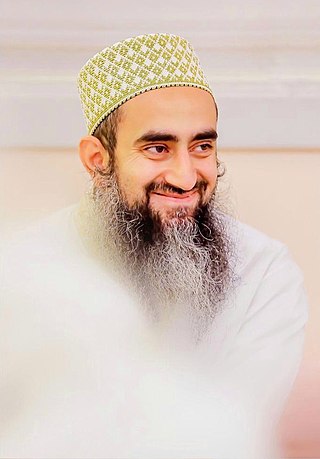
Shahzada Husain Burhanuddin, also known as Husain Mufaddal Saifuddin, is the third and youngest son of Mufaddal Saifuddin, the current incumbent of the office of the 53rd Da'i al-Mutlaq. He is a Qāriʾ and an honorary member of Naqabāt Qurrāʾ al-Quran in Cairo. He is currently the Chairman of Saifee Burhani Upliftment Trust.
The Qur'an is meant to be recited. Its verses are divided according to the rhythm of the language. The Qur'anic punctuation is, therefore, not only based on the structure or the syntax of the sentence, but also on the need to pause, for breath or for effect. Pickthall observes, when a certain sound which marks the rhythm recurs, there is a strong pause and the verse ends naturally, although the sentence may go on to the next verse. Thus the Qur'anic punctuation affects the pronunciation of the words, rhythm, intonation and syllable separation.
The Cairo edition, or the King Fu'ād Quran or the Azhar Quran, is an edition of the Quran printed by the Amiri Press in the Bulaq district of Cairo on July 10, 1924. It is the first printed Quran to be accepted by a Muslim authority, this authority being Al-Azhar.
References
- ↑ quran.com (October 1996) "Al-Quran Al-Kareem on CD-ROM software is developed by Mirco Systems International, a company based in Champaign, Illinois, U.S.A. This program is the original Quran on CD software. Micro Systems has been continually improving features and other aspects of the program since 1990, making it the best multimedia tool for learning the Quran today."
- ↑ muttaqun.com had a transliteration of the Arabic text alongside GIF graphics of the text in Arabic script online in 2000. searchtruth.com had an electronic text online in 2004. quran.com (2007) hosted the Yusuf Ali English translation, adding the Arabic text in 2008. qurany.net and quranexplorer.com had the Arabic text online from 2006. quranflash.com followed in 2007 using Adobe Flash to show animations of turning pages.
- ↑ Indonesians tune in to digital Koran Reuters SEPTEMBER 21, 2007; introduced in [ when? ] by the Korean company; Penman Corporation
- ↑ Example of Digital Qur'an for Smartphones
- ↑ Living the Information Society in Asia; Erwin Alampay
- ↑ Alwi, Engku Ahmad Zaki Engku; Anas, Norazmi; Ibrahim, Mohd. Syahril; Dahan, Ahmad Fadhir Mat; Yaacob, Zuriani (2014-07-11). "Digital Quran Applications on Smart Phones and Tablets: A Study of the Foundation Programme Students". Asian Social Science. 10 (15). doi: 10.5539/ass.v10n15p212 . ISSN 1911-2025.
- ↑ "there may be a place on a separate portion of a believer's hard drive, apart from other forms of content of a nonreligious nature, for a digital Qur'an" Gary R. Bunt, iMuslims, 2009, p.87
- ↑ "But this perception is a 'western' one and not that of the Arab reader, to whom modern technology is something strange and foreign, technological containers which can be imported and used without any analysis of their actual content (Example: Digital Koran)." The Almost Complete Lack of the Element of "Futureness" Heise Online
- ↑ Kristina Myrvold, The Death of Sacred Texts: Ritual Disposal and Renovation of Texts in World Religions, 2010, p. 47, citing a 2008 fatqa at "askimam.com" phrased "Do You Have to Have Wudu When Handling a Digital Quran?"
- ↑ Zakariah, Mohammed; Khan, Muhammad Khurram; Tayan, Omar; Salah, Khaled (August 2017). "Digital Quran Computing: Review, Classification, and Trend Analysis". Arabian Journal for Science and Engineering. 42 (8): 3077–3102. doi:10.1007/s13369-017-2415-4. S2CID 63594225. ProQuest 1919663740.
- ↑ Hoffmann, Thomas (2013). Muslims and the New Information and Communication Technologies Notes from an Emerging and Infinite Field. Springer Netherlands: Dordrecht : Springer Netherlands : Imprint: Springer. ISBN 978-94-007-7247-2.
- ↑ ProQuest 1551172691 [ full citation needed ]
- ↑ http://webcast.bibalex.org/Cast/Details.aspx?ID=11438
- ↑ Bunt, Gary (2018). Hashtag Islam. The University of North Carolina Press: The University of North Carolina Press. pp. 39–40. ISBN 9781469643151.
- ↑ "learn Quran with tajweed online". BeinQuran. Retrieved 2022-03-23.
- ↑ Bunt, Gary (2018). Hashtag Islam. The University of North Carolina Press: The University of North Carolina Press. p. 36. ISBN 9781469643168.
- 1 2 Zakariah, Mohammed; Khan, Muhammad Khurram; Tayan, Omar; Salah, Khaled (August 2017). "Digital Quran Computing: Review, Classification, and Trend Analysis". Arabian Journal for Science and Engineering. 42 (8): 3077–3102. doi:10.1007/s13369-017-2415-4. ISSN 2193-567X. S2CID 63594225.
- 1 2 3 Hakak, Saqib; Kamsin, Amirrudin; Tayan, Omar; Idna Idris, Mohd. Yamani; Gani, Abdullah; Zerdoumi, Saber (2017). "Preserving Content Integrity of Digital Holy Quran: Survey and Open Challenges". IEEE Access. 5: 7305–7325. doi: 10.1109/ACCESS.2017.2682109 . ISSN 2169-3536.
- ↑ Kurniawan, Fajri; Khalil, Mohammed S.; Khan, Muhammad Khurram; Alginahi, Yasser M. (December 2013). "Exploiting Digital Watermarking to Preserve Integrity of the Digital Holy Quran Images". 2013 Taibah University International Conference on Advances in Information Technology for the Holy Quran and Its Sciences. Madinah, Saudi Arabia: IEEE. pp. 30–36. doi:10.1109/NOORIC.2013.18. ISBN 9781479928231. S2CID 13993235.
- ↑ Kamaruddin, Nurul Shamimi; Kamsin, Amirrudin; Hakak, Saqib (2017). "Associated diacritical watermarking approach to protect sensitive arabic digital texts". American Institute of Physics Conference Series. AIP Conference Proceedings. 1891 (1). Kedah, Malaysia: 020074. Bibcode:2017AIPC.1891b0074K. doi: 10.1063/1.5005407 .
- ↑ Abukhir, Khir Zuhaili; Idris, Mohd Yamani Idna; Tayan, Omar; Palaiahnakote, Shivakumara; Kamsin, Amirrudin; Hakak, Saqib (2018-06-20). "Residual-based approach for authenticating pattern of multi-style diacritical Arabic texts". PLOS ONE. 13 (6): e0198284. Bibcode:2018PLoSO..1398284H. doi: 10.1371/journal.pone.0198284 . ISSN 1932-6203. PMC 6010264 . PMID 29924810.